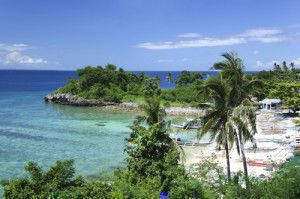10 of the world’s most amazing places
One of our top tips for learning a language is to take a holiday – it not only gives you a chance to practise your new language with the locals but you also get to visit somewhere nice. And why not take the opportunity to visit some of the world’s most amazing (if sometimes slightly bizarre) places while you’re at it?
1. San Alfonso del Mar
Like the world’s largest swimming pool, for instance, which is at San Alfonso del Mar in Chile. If you’re thinking of swimming lengths, you might want to stock up on energy drinks before diving in to this one. It’s more than 1,013 metres long, so paddlers should beware! It also has a 35-metre deep end – not for the unwary swimmer. The Guinness Book of Records named this pool as the biggest in the world, needing 66 million gallons of water to fill it up.
2. Mt HuaShan
Or maybe you’d like to visit a traditional Chinese tea house. What about this one, at the top of Mt. HuaShan? It’s 2,160 metres high and the path to get there is nothing short of terrifying. It’s thought that there may be as many as 100 fatal falls a year, and yet the trail is popular with tourists, keen to visit the teahouse, on the southern summit of the mountain, which used to be a Taoist temple, or the chess pavilion on the east peak.
3. Stewart Island
If bird-watching is your thing, you could visit Stewart Island in New Zealand. It’s one of the most remote destinations in the world, with only one town, Halfmoon Bay (also known as Oban) and an estimated population of just 450 people. The island is the only place to see the Kiwi bird in its natural habitat and is also home to five species of penguin.
4. Pink Lake
Next door in Australia, Pink Lake, just west of Esperance, is worth a visit. As its name would suggest, in certain weather conditions the water in the lake is pink, thanks to a particular kind of algae in the water. And this isn’t the only pink lake in the area. Lake Hillier, on Middle Island, is another example and an even brighter colour.
5. Joffre Lakes
However, if you prefer your lakes blue, the Canadian park of Joffre Lakes in British Columbia comes highly recommended. The lakes are a more traditional, but stunningly beautiful, turquoise blue and surrounded by peaks and glaciers. A trip to Joffre Lakes isn’t complete without an overnight stay, where you can camp under the stars and listen to the ice calving from the glacier.
6. Kizhi
The Russian island of Kizhi is found almost exactly at the centre of Lake Onega and boasts a spectacular wooden church, the Church of the Transfiguration, which was built in the 18th century without a single nail. Legend says that the lead builder used just one axe for the whole building, and then threw it in the lake when the church was completed, saying, ‘There was not and will not be another one to match it.’
7. Kayaköy
Just a few miles from the popular resort of Fethiye in southwestern Turkey, on the side of a mountain, is the village of Kayaköy. Greek-speaking Christians lived there until the 1920s but the village was abandoned follow a population exchange agreement between Turkey and Greece in 1923. Now a museum and historical monument, Kayaköy is a beautiful but rather eerie ghost town.
8. Capuchin monastery
Speaking of eerie, the Capuchin monastery in Sicily is home to 8,000 mummified corpses in the monastery catacombs. The bodies are all dressed in their best clothes and arranged in different rooms according to the type of person. The oldest in the collection dates from 1599, while the most recent addition is the body of Rosalia Lomabardo, who was embalmed in 1920 and is known as ‘Sleeping Beauty’.
9. ICEHOTEL
If you’re looking for somewhere a bit different to stay, you could try the ICEHOTEL in Jukkasjärvi, Sweden. Made with ice from the Torne River, the hotel offers ice and snow rooms, and runs a survival course every night for new guests on what to wear and how to cope when sleeping in temperatures below zero. But don’t worry – warm rooms are also available if you’re not a fan of the cold.
10. Malapascua
One extreme to the other – the island of Malapascua in the Phillippines boasts beautiful beaches and is most popular with divers, as it’s the only place in the world to see the pelagic thresher shark. There’s no transport on the island because it’s small enough to walk everywhere, and the only way to arrive on the island is by banca (a local boat ferry).
We hope that’s given you a few ideas for your next holiday. Don’t forget to learn a few words in the local language before you leave! And if we missed your favourite place, let us know in the comments…
EuroTalk’s Top 10 Tips for Learning a Language in 2014 [Infographic]
Happy New Year! As life begins to return to normal, it’s time to get going on our New Year’s Resolutions (assuming we haven’t broken them already…) Many people will be taking the opportunity to learn a language, so we’ve put together this handy infographic with our top 10 tips to keep you motivated. Enjoy!
If you’ve enjoyed our infographic, please share it with others using one of the options below. We’d love to hear which languages you’re learning too, and how it’s going, so do let us know in the comments.
Read more about this in our recent blog post, Learning a Language – our top 10 tips.
Embed This Image On Your Site (copy code below):
Learning a language – our top 10 tips
We all know learning a language is a great idea, but sometimes it can be hard to get motivated or to find the right way to learn. Here are our top 10 tips to help you get started.
1. Tell everyone you know that you’re learning a language.
This way, when you’re tempted to give up or chicken out, you might think twice knowing they’re all expecting great things from you. I call this ‘the biscuit tin method’; if you tell everyone you’re giving up biscuits, you’re a lot less likely to cave, just in case you get caught with your hand in the tin. It worked for me – I haven’t had a biscuit in years. Well, not out of the tin, anyway.
2. Start with the basics.
We know you might be learning French for an important business meeting, but you may not get a chance to show off the fact that you know how to say ‘Sales in the retail sector are growing steadily’, if you’ve not yet learnt how to say ‘hello’.
3. Don’t be scared to talk to people.
You might get it wrong sometimes, but if you don’t try, you’ll never get it right, either. In the immortal words of Richard Branson, ‘You don’t learn to walk by following rules. You learn by doing, and falling over.’ Learning on paper is all well and good, but talking to people and making mistakes is the best way to pick new things up. And you’re more likely to get it right next time, because you’ll remember the situation you were in as well as just the word or phrase.
(This works both ways, actually – if you know someone who’s learning your language and they say something incorrectly, let them know about it. Not in a mean way, but in a helpful, constructive way so they understand where they went wrong and can get it right next time. And you’ll probably find it helps you understand your own language better, too.)
4. Don’t worry too much about grammar to begin with.
Yes, it’s important, but if you’re making the effort to talk to someone in their own language, as long as you can make yourself understood, they probably won’t mind if you get your verb ending wrong. So get your basic vocab and some stock phrases down first, then you can start learning some basic grammar to help you create your own sentences and take your study of the language further.
5. Make yourself some flashcards.
Or use a computer program or mobile app. (We hear uTalk‘s quite good…) Introducing an element of competition can be a good motivator, so see if you can team up with someone else who’s learning the same language and test each other, or compare your online scores. If you don’t have time to sit down and make flashcards, you could try labelling things around your house or workspace, so you see them all the time and the vocabulary will start to sink in without you even realising.
6. Find someone to talk to.
If you’re learning for a trip, then this is easy; there’ll be loads of people to chat to when you get there. But if you’re just learning for fun, try and find someone to practise with. A lot of the world is so multicultural now that it’s possible to find a native speaker of just about any language living just down the road. But even if you can’t, there are loads of websites where you can find someone to Skype with, even if they live on the other side of the world. For instance, italki is free and lets you connect with language teachers and native speakers around the world. The best part is, you might make a new friend, which can only mean one thing – cheap holidays…
7. Read, watch and listen to anything you can find.
If you’re at home, this could be newspapers, books, movies, music or websites. Or if you’re travelling, look at signs, menus or product packaging. If there are words you don’t understand, make a note of them and look them up later, or ask someone. You’ll probably be surprised how much you can piece together on your own, and that’s a great confidence boost.
8. Go to the country.
Even if you’re just learning for fun, there’s no better way to learn a language than to immerse yourself in it. Plan a holiday – if nothing else it’ll give you something to look forward to and will motivate you to keep learning. Visiting a country also means that you’ll learn the ‘real’ way of saying things – you might have learnt the correct way but when you arrive, you’ll find nobody actually talks that way.
9. Don’t give up.
It’s not easy to learn a language, but we all have the ability. There really is no such thing as someone who’s bad at languages. So if you’re finding it difficult, hang in there; it’ll be worth it in the end. And keep practising, because you may find all that vocab you spent ages learning will drift away if you don’t. Which seems like a shame.
10. Enjoy it.
We all remember our school days, studying French verbs and monotonously repeating meaningless sentences about your cats on tables. But learning a language can open up a world full of opportunities, new friends and different ways of seeing the world around us. So why make it a chore? Be creative – everyone’s different so do whatever works for you. You could try singing, for example. Or blogging about your learning journey. Try different things and see what works. And then tell us about it – we’d love to hear from you 🙂
Good luck!
Liz (with contributions from Alex and Nat)
You can now read and share this post in a handy infographic!






